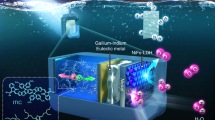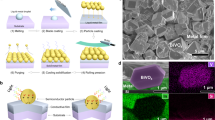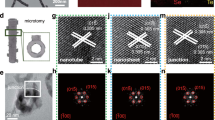Abstract
Organic semiconductors hold promise to enable scalable, low-cost and high-performance artificial photosynthesis. However, the performance of systems based on organic semiconductors for light-driven water oxidation have remained poor compared with inorganic semiconductors. Herein, we demonstrate an all-polymer bulk heterojunction organic semiconductor photoanode for solar water oxidation. By engineering the photoanode interlayers we gain important insights into critical factors (surface roughness and charge extraction efficiency) to increase the operational stability, which reaches above 3 h with a 1-Sun photocurrent density, Jph, of >3 mA cm−2 at 1.23 V versus the reversible hydrogen electrode for the sacrificial oxidation of Na2SO3 at pH 9. Optimizing the coupling to an oxygen evolution catalyst yields O2 production with Jph > 2 mA cm−2 at 1.23 V versus the reversible hydrogen electrode (100% Faradaic efficiency and a quantum efficiency up to 27% with 610 nm illumination), demonstrating improved stability (≥1 mA cm−2 for over 30 min of continuous operation) compared with previous organic photoanodes.

This is a preview of subscription content, access via your institution
Access options
Access Nature and 54 other Nature Portfolio journals
Get Nature+, our best-value online-access subscription
$29.99 / 30 days
cancel any time
Subscribe to this journal
Receive 12 digital issues and online access to articles
$119.00 per year
only $9.92 per issue
Buy this article
- Purchase on Springer Link
- Instant access to full article PDF
Prices may be subject to local taxes which are calculated during checkout




Similar content being viewed by others
Data Availability
Source data are provided with this paper. All data generated or analysed during this study are included in this published article and its Supplementary Information files, or are available from the authors upon reasonable request.
References
Davis, S. J. et al. Net-zero emissions energy systems. Science 360, eaas9793 (2018).
Kim, J. H., Hansora, D., Sharma, P., Jang, J.-W. & Lee, J. S. Toward practical solar hydrogen production – an artificial photosynthetic leaf-to-farm challenge. Chem. Soc. Rev. 48, 1908–1971 (2019).
Ardo, S. et al. Pathways to electrochemical solar-hydrogen technologies. Energy Environ. Sci. 11, 2768–2783 (2018).
Tachibana, Y., Vayssieres, L. & Durrant, J. R. Artificial photosynthesis for solar water-splitting. Nat. Photonics 6, 511–518 (2012).
Sivula, K. & van de Krol, R. Semiconducting materials for photoelectrochemical energy conversion. Nat. Rev. Mater. 1, 15010 (2016).
Hisatomi, T. & Domen, K. Reaction systems for solar hydrogen production via water splitting with particulate semiconductor photocatalysts. Nat. Catal. 2, 387–399 (2019).
Pinaud, B. A. et al. Technical and economic feasibility of centralized facilities for solar hydrogen production via photocatalysis and photoelectrochemistry. Energy Environ. Sci. 6, 1983–2002 (2013).
Yang, Y. et al. Progress in developing metal oxide nanomaterials for photoelectrochemical water splitting. Adv. Energy Mater. 7, 1700555 (2017).
Chandrasekaran, S. et al. Recent advances in metal sulfides: from controlled fabrication to electrocatalytic, photocatalytic and photoelectrochemical water splitting and beyond. Chem. Soc. Rev. 48, 4178–4280 (2019).
Luo, Z., Wang, T. & Gong, J. Single-crystal silicon-based electrodes for unbiased solar water splitting: current status and prospects. Chem. Soc. Rev. 48, 2158–2181 (2019).
Zheng, J. et al. Efficiency and stability of narrow-gap semiconductor-based photoelectrodes. Energy Environ. Sci. 12, 2345–2374 (2019).
Jiang, C., Moniz, S. J. A., Wang, A., Zhang, T. & Tang, J. Photoelectrochemical devices for solar water splitting – materials and challenges. Chem. Soc. Rev. 46, 4645–4660 (2017).
Serpone, N. et al. Why do hydrogen and oxygen yields from semiconductor-based photocatalyzed water splitting remain disappointingly low? Intrinsic and extrinsic factors impacting surface redox reactions. ACS Energy Lett. 1, 931–948 (2016).
Wang, Y. et al. Current understanding and challenges of solar-driven hydrogen generation using polymeric photocatalysts. Nat. Energy 4, 746–760 (2019).
Yao, L., Rahmanudin, A., Guijarro, N. & Sivula, K. Organic semiconductor based devices for solar water splitting. Adv. Energy Mater. 8, 1802585 (2018).
Steier, L. & Holliday, S. A bright outlook on organic photoelectrochemical cells for water splitting. J. Mater. Chem. A 6, 21809–21826 (2018).
Bellani, S., Antognazza, M. R. & Bonaccorso, F. Carbon-based photocathode materials for solar hydrogen production. Adv. Mater. 31, 1801446 (2019).
Zhang, G., Lan, Z.-A. & Wang, X. Conjugated polymers: catalysts for photocatalytic hydrogen evolution. Angew. Chem. Int. Ed. 55, 15712–15727 (2016).
Bronstein, H., Nielsen, C. B., Schroeder, B. C. & McCulloch, I. The role of chemical design in the performance of organic semiconductors. Nat. Rev. Chem. 4, 66–77 (2020).
Yu, G., Gao, J., Hummelen, J. C., Wudl, F. & Heeger, A. J. Polymer photovoltaic cells: enhanced efficiencies via a network of internal donor-acceptor heterojunctions. Science 270, 1789–1791 (1995).
Yao, L. et al. Establishing stability in organic semiconductor photocathodes for solar hydrogen production. J. Am. Chem. Soc. 142, 7795–7802 (2020).
Kosco, J. et al. Enhanced photocatalytic hydrogen evolution from organic semiconductor heterojunction nanoparticles. Nat. Mater. 19, 559–565 (2020).
Espinosa, N., Hösel, M., Angmo, D. & Krebs, F. C. Solar cells with one-day energy payback for the factories of the future. Energy Environ. Sci. 5, 5117–5132 (2012).
Zhang, K., Ma, M., Li, P., Wang, D. H. & Park, J. H. Water splitting progress in tandem devices: moving photolysis beyond Electrolysis. Adv. Energy Mater. 6, 1600602 (2016).
Ng, B. et al. Z‐ccheme photocatalytic systems for solar water splitting. Adv. Sci. 7, 1903171 (2020).
Kirner, J. T. & Finke, R. G. Water-oxidation photoanodes using organic light-harvesting materials: a review. J. Mater. Chem. A 5, 19560–19592 (2017).
Bornoz, P., Prévot, M. S., Yu, X., Guijarro, N. & Sivula, K. Direct light-driven water oxidation by a ladder-type conjugated polymer photoanode. J. Am. Chem. Soc. 137, 15338–15341 (2015).
Mansha, M., Khan, I., Ullah, N., Qurashi, A. & Sohail, M. Visible-light driven photocatalytic oxygen evolution reaction from new poly(phenylene cyanovinylenes). Dyes Pigm. 143, 95–102 (2017).
Abe, T. et al. An organic photoelectrode working in the water phase: visible-light-induced dioxygen evolution by a perylene derivative/cobalt phthalocyanine bilayer. Angew. Chem. Int. Ed. 45, 2778–2781 (2006).
Kirner, J. T., Stracke, J. J., Gregg, B. A. & Finke, R. G. Visible-light-assisted photoelectrochemical water oxidation by thin films of a phosphonate-functionalized perylene diimide plus CoOx cocatalyst. ACS Appl. Mater. Interfaces 6, 13367–13377 (2014).
Wang, L. et al. Improved stability and performance of visible photoelectrochemical water splitting on solution-processed organic semiconductor thin films by ultrathin metal oxide passivation. Chem. Mater. 30, 324–335 (2018).
Eom, Y. K. et al. Visible-light-driven photocatalytic water oxidation by a π-conjugated donor–acceptor–donor chromophore/catalyst assembly. ACS Energy Lett. 3, 2114–2119 (2018).
Kirner, J. T. & Finke, R. G. Sensitization of nanocrystalline metal oxides with a phosphonate-functionalized perylene diimide for photoelectrochemical water oxidation with a CoOx catalyst. ACS Appl. Mater. Interfaces 9, 27625–27637 (2017).
Wee, K.-R. et al. An aqueous, organic dye derivatized SnO2/TiO2 core/shell photoanode. J. Mater. Chem. A 4, 2969–2975 (2016).
Park, S.-Y. et al. Stable organic-inorganic hybrid multilayered photoelectrochemical cells. J. Power Sources 341, 411–418 (2017).
Liu, G., Chen, C., Ji, H., Ma, W. & Zhao, J. Photo-electrochemical water splitting system with three-layer n-type organic semiconductor film as photoanode under visible irradiation. Sci. China Chem. 55, 1953–1958 (2012).
Distler, A. et al. The effect of PCBM dimerization on the performance of bulk heterojunction solar cells. Adv. Energy Mater. 4, 1300693 (2014).
Cheng, P., Li, G., Zhan, X. & Yang, Y. Next-generation organic photovoltaics based on non-fullerene acceptors. Nat. Photonics 12, 131–142 (2018).
Kang, T. E. et al. Importance of optimal composition in random terpolymer-based polymer solar cells. Macromolecules 46, 6806–6813 (2013).
Kim, T. et al. Flexible, highly efficient all-polymer solar cells. Nat. Commun. 6, 8547 (2015).
Cho, H.-H. et al. Design of cyanovinylene-containing polymer acceptors with large dipole moment change for efficient charge generation in high-performance all-polymer solar cells. Adv. Energy Mater. 8, 1701436 (2018).
Kim, T. W. & Choi, K.-S. Nanoporous BiVO4 photoanodes with dual-layer oxygen evolution catalysts for solar water splitting. Science 343, 990–994 (2014).
Fekete, M., Riedel, W., Patti, A. F. & Spiccia, L. Photoelectrochemical water oxidation by screen printed ZnO nanoparticle films: effect of pH on catalytic activity and stability. Nanoscale 6, 7585–7593 (2014).
Cai, C. & Dauskardt, R. H. Nanoscale interfacial engineering for flexible barrier films. Nano Lett. 15, 6751–6755 (2015).
Huang, Q. et al. Recombination in SnO2-based quantum dots sensitized solar cells: the role of surface states. J. Phys. Chem. C. 117, 10965–10973 (2013).
Wang, D. et al. Self-assembled chromophore–catalyst bilayer for water oxidation in a dye-sensitized photoelectrosynthesis cell. J. Phys. Chem. C. 123, 30039–30045 (2019).
Li, S.-S. & Chen, C.-W. Polymer–metal-oxide hybrid solar cells. J. Mater. Chem. A 1, 10574–10591 (2013).
Gao, J. et al. Breaking long-range order in iridium oxide by alkali ion for efficient water oxidation. J. Am. Chem. Soc. 141, 3014–3023 (2019).
Dincă, M., Surendranath, Y. & Nocera, D. G. Nickel-borate oxygen-evolving catalyst that functions under benign conditions. Proc. Natl Acad. Sci. USA 107, 10337–10341 (2010).
Abdou, M. S. A. & Holdcroft, S. Mechanisms of photodegradation of poly(3-alkylthiophenes) in solution. Macromolecules 26, 2954–2962 (1993).
Lee, J. U., Jung, J. W., Jo, J. W. & Jo, W. H. Degradation and stability of polymer-based solar cells. J. Mater. Chem. 22, 24265–24283 (2012).
Heo, J. H. et al. Efficient inorganic–organic hybrid heterojunction solar cells containing perovskite compound and polymeric hole conductors. Nat. Photonics 7, 486–491 (2013).
Noh, J., Jeong, S. & Lee, J.-Y. Ultrafast formation of air-processable and high-quality polymer films on an aqueous substrate. Nat. Commun. 7, 12374 (2016).
Yun, H.-J. et al. Dramatic inversion of charge polarity in diketopyrrolopyrrole-based organic field-effect transistors via a simple nitrile group substitution. Adv. Mater. 26, 7300–7307 (2014).
Jeanbourquin, X. A. et al. Amorphous ternary charge-cascade molecules for bulk heterojunction photovoltaics. ACS Appl. Mater. Interfaces 9, 27825–27831 (2017).
Cho, H.-H. et al. Synthesis and side-chain engineering of phenylnaphthalenediimide (PNDI)-based n-type polymers for efficient all-polymer solar cells. J. Mater. Chem. A 5, 5449–5459 (2017).
Ke, W. et al. Low-temperature solution-processed tin oxide as an alternative electron transporting layer for efficient perovskite solar cells. J. Am. Chem. Soc. 137, 6730–6733 (2015).
Yan, K. et al. Hybrid halide perovskite solar cell precursors: colloidal chemistry and coordination engineering behind device processing for high efficiency. J. Am. Chem. Soc. 137, 4460–4468 (2015).
Acknowledgements
We acknowledge support from the Swiss Competence Centre for Energy Research (SCCER Heat and Electricity Storage, contract number CTI 1155002545). N.G. and Y.L. thank the Swiss National Foundation (SNF) for funding under an Ambizione Energy Grant (PZENP2_166871). J.-H.Y. thanks a research agreement between EPFL and the Korea Electric Power Corporation (KEPCO).
Author information
Authors and Affiliations
Contributions
K.S. and H.-H.C. conceived and designed the project. H.-H.C. prepared the photoanodes and measured the PEC performance. H.-H.C. and L.Y. performed the IPCE and GC measurements. H.-H.C. and J.-H.Y. prepared the ETLs and HTLs and performed the contact angle measurements. H.-H.C., Y.L. and R.A.W. performed the SEM and TEM measurements. Y.L. and F.B. analysed the impedance data. H.-H.C. and N.G. characterized the OER catalysts. H.-H.C. and A.S. synthesized the polymer donor and acceptor. K.S. and H.-H.C. prepared the manuscript and subsequent editing/improvement was performed by all authors.
Corresponding author
Ethics declarations
Competing interests
The authors declare no competing interests.
Additional information
Peer review information Nature Catalysis thanks Ludmilla Steier and the other, anonymous, reviewer(s) for their contribution to the peer review of this work.
Publisher’s note Springer Nature remains neutral with regard to jurisdictional claims in published maps and institutional affiliations.
Supplementary information
Supplementary Information
Supplementary Methods, Discussions, Figs. 1–30, Tables 1 and 2 and References.
Supplementary Data 1
Source data for the chronoamperometric plots in Supplementary Figs. 3b, 4, 6b, 11b, 12d, 13b, 15b, 20b, 28b, 29b and 30b.
Source data
Source Data Fig. 2
Source data for the chronoamperometric plot.
Source Data Fig. 3
Source data for the chronoamperometric plot.
Rights and permissions
About this article
Cite this article
Cho, HH., Yao, L., Yum, JH. et al. A semiconducting polymer bulk heterojunction photoanode for solar water oxidation. Nat Catal 4, 431–438 (2021). https://doi.org/10.1038/s41929-021-00617-x
Received:
Accepted:
Published:
Issue Date:
DOI: https://doi.org/10.1038/s41929-021-00617-x
This article is cited by
-
High-spin Co3+ in cobalt oxyhydroxide for efficient water oxidation
Nature Communications (2024)
-
The Photocharging Effect and Part Electronic Structure Changes of Organic Semiconductors in Photoelectrochemical Water Splitting
Catalysis Letters (2024)
-
Enhanced photoelectrochemical water splitting with a donor-acceptor polyimide
Frontiers in Energy (2023)
-
Homogeneous solution assembled Turing structures with near zero strain semi-coherence interface
Nature Communications (2022)
-
General heterostructure strategy of photothermal materials for scalable solar-heating hydrogen production without the consumption of artificial energy
Nature Communications (2022)



